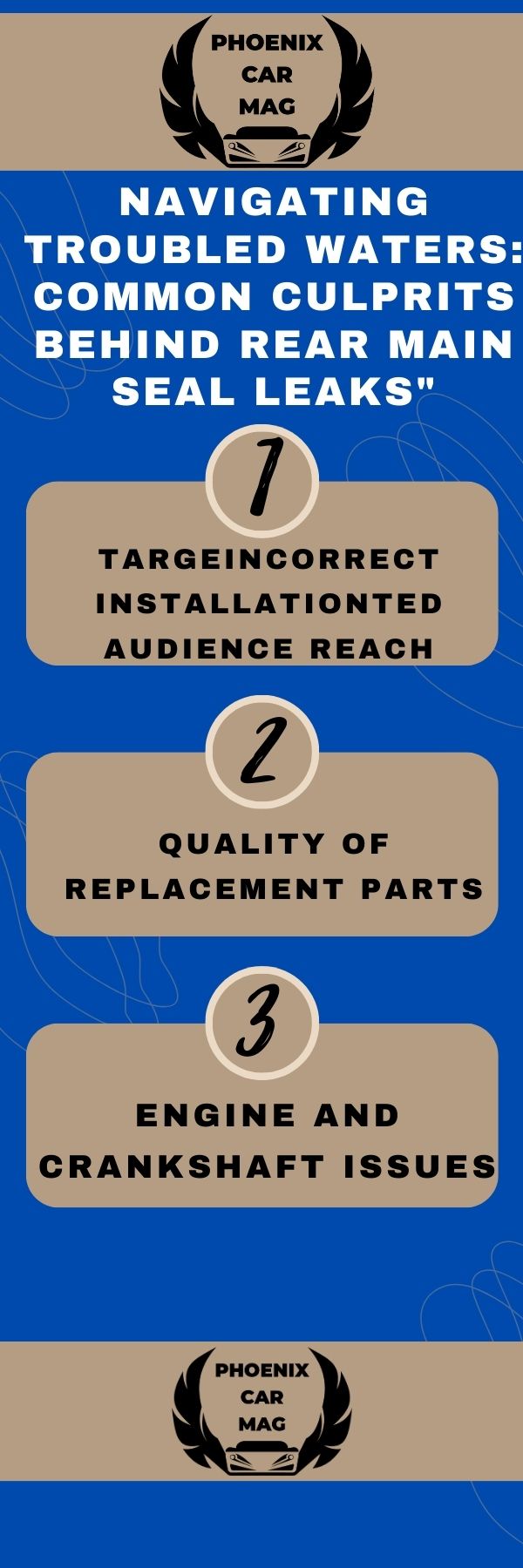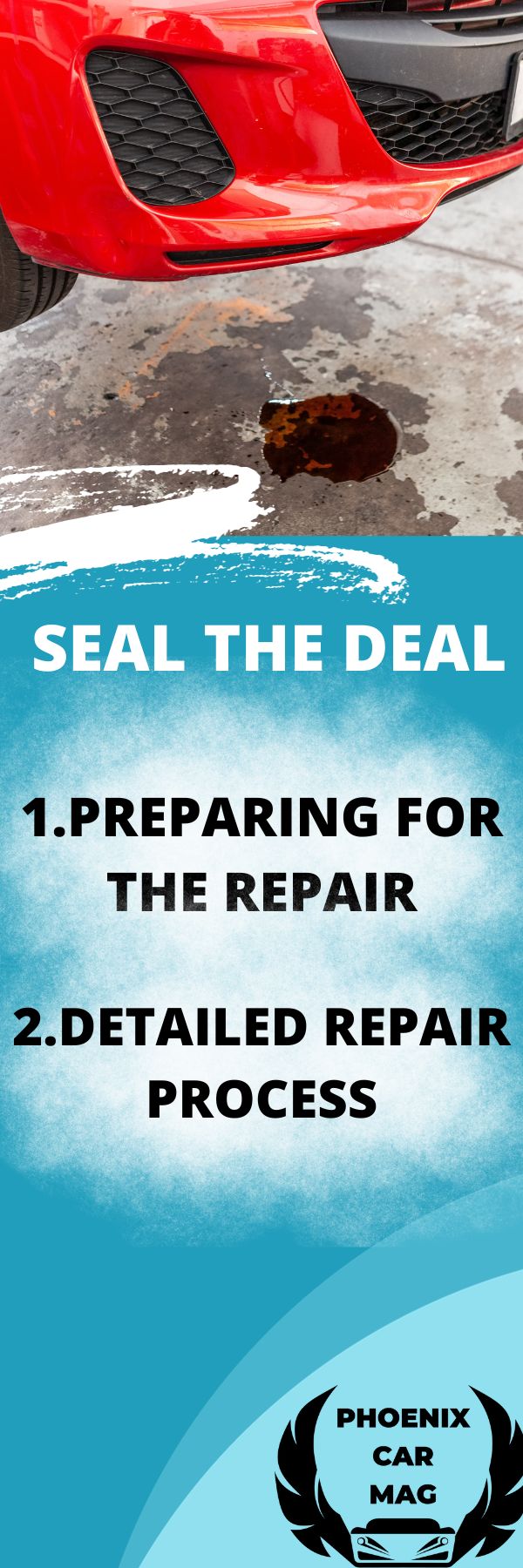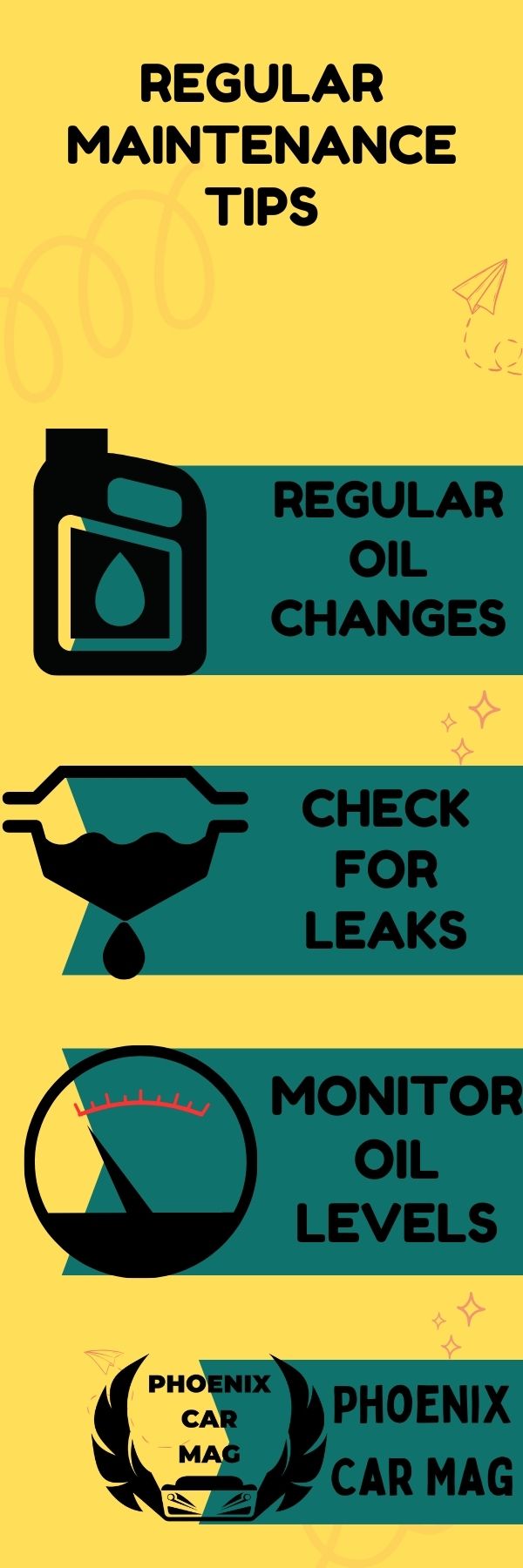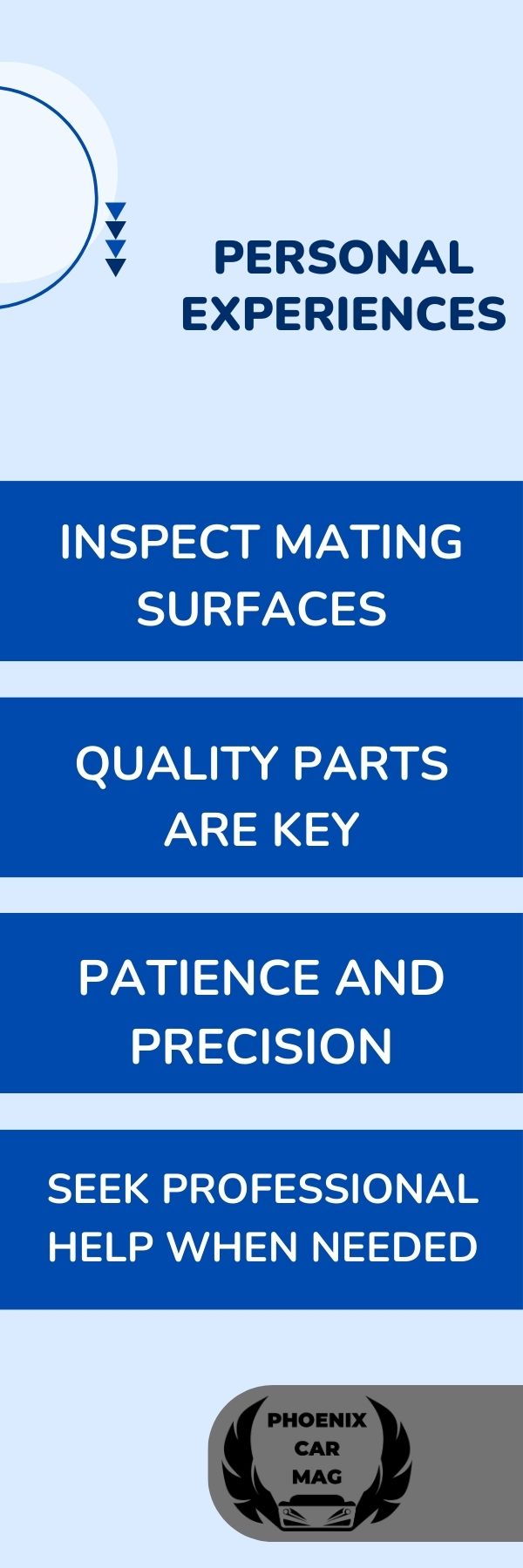Hi there. I’m Isaac V. Mace the founder of Phoenix Car Mag. I’ve had the experience of working with various vehicles and dealing with their challenging issues. Now, I’m here to share the experience related to the rear main seal leaking after replacement with you. We’re going to find out its reasons and figure out the ways to fix it.
I faced with this issue just a few months ago. I’ve replaced my rear main seal recently and I was concerned with its leaking last week.
I was wondering about its cause so I figured it out through an inspection. So, what should you do when your rear main seal is leaking after replacement? The main seal leaking after replacement is the result of improper installation. First, confirm the correct orientation of the seal; installing it backward is a common mistake. Also, make sure to crankshaft’s surface where the seal will sit; any nicks or damage can cause the new seal to fail.
The cause lies in small details including alignment, torque specifications, and the crankshaft surface. Despite being tricky, I will spot a light on this issue in this article so of you’re struggling with the same situation, you’re standing at the right place.
You might also enjoy: 1.5JZ Engine – This Is My Experience About This Engine [2024]
The Unsung Hero Under the Hood: Understanding the Rear Main Seal”
It might sound weird but according to my long-term experience under several car hoods, you should consider all of your vehicle’s components as vital ones and avoid overlooking them. The rear main seal is one of the overlooked parts.
This component is similar to quiet but clever students of a class.
They play a crucial role while they’re quiet. The rear main seal is located between the crankshaft and transmission to prevent the engine oil from leaking out.
Didn’t understand the importance of the rear main seal’s role yet? This vital component is there to maintain the oil inside the engine to lubricate all the components. In case it malfunctions, the engine oil leaks out and the engine components including the crankshaft aren’t lubricated sufficiently.
This leads to the improper function of the crankshaft and the engine’s rough performance.
However, it’s not all about the rough performance of the vehicle. As time passes, the rear main seal is exposed to the engine’s high temperature and vibrations.
This leads to premature wear and tear and once it happens, you will realize the leaking. That’s why you should address this issue promptly. To do this, consider inspecting the rear main seal regularly and check for any signs of leaks or damage.
Replacing the rear main seal isn’t a straightforward process as it’s inside the engine and you should separate the engine and transmission’s components to reach it. Knowing this, it’s wiser to be attentive to regular maintenance to address the issue in its first steps rather than trying to repair it after complete failure.
I think now you have a more thoughtful perspective of the rear main seal’s issues and fixes. However, there’s a lot more to be said about this controversial issue. Stay tuned for the rest of this article to use all my real-life experiences.
You might also enjoy: What Happens If You Unplug Idle Air Control Valve [2024] – My Personal Experience
Navigating Troubled Waters: Common Culprits Behind Rear Main Seal Leaks”
As I’ve replaced many rear main seals in these years and faced their leaking challenges, I can tell you the reasons for this issue. Common causes include:
1. Incorrect Installation
You might consider the rear main seal installation as a simple procedure but it’s a demanding one. It requires precision and expertise. The installer should align the rear main seal against the crankshaft properly. In case of misalignment or wrong torques on bolts, you face leaking after the replacement.
2. Quality of Replacement Parts
Regardless of the installation process, let’s talk about the rear main seal itself. It’s worth mentioning that the rear main seal is located in a harsh environment in the engine. It’s exposed to high temperatures and vibrations so you should consider using a high-quality component. If you refuse to buy a high-quality rear main seal, you might save your money however be prepared for premature wear and tear and many headaches on the road.
3. Engine and Crankshaft Issues
In some situations, the leaking is not a result of low-quality rear main seal or improper installation. It’s due to the engine’s problems such as worn-out crankshaft or loose bearings. In these situations, you should consider fixing these underlying issues and then check the quality of the component and its proper installation.
In similar cases to yours, try to diagnose the main cause of the issue. If you do it successfully, you’ve done the most important part of the repair process. It prevents you from paying excessive money and experiencing hard situations on the road. Stay with me to teach you some tips for keeping your engine’s reliability.
Seal the Deal: A DIY Guide to Fixing Rear Main Seal Leaks”
In these years in my repair shop, I dealt with various car issues. Some issues like the rear main seal’s leaking are demanding and require precision so even seasoned car owners and enthusiasts are unable to fix it. I decided to share some useful tips here to enable you to manage this daunting issue by yourself.
Steps to Fixing a Rear Main Seal Leak:
1. Preparing for the Repair
As you might know, it’s always better to prepare your required materials before starting work. For a rear main seal replacement, you need a new rear main seal and perhaps some extra components like a gasket or a sealant. Also, try to start working in a quiet and safe place and consider having your manual beside you to refer to it when it’s necessary.
2. Detailed Repair Process
Once you prepared all you need, it’s time to head to the repairing process. Despite the difference in this process in different vehicles, here is a general instruction:
- Remove Necessary Components: To reach the seal, you should lift and remove the heavy components like the driveshaft.
- Access the Rear Main Seal: After the mentioned component’s removal, you reach the rear main seal. You see it surrounding the crankshaft.
- Remove the Old Seal: Remove the worn-out and faulty seal with precision. Remember you shouldn’t do it with shaking hands as it damages other surrounding components like the crankshaft.
- Clean and Inspect: Once you remove the old rear main seal, consider cleaning the area before installing the new one. Check the area for any damages and clean it as the dirt can be the cause of leaking.
- Install the New Seal: It’s the most important and daunting part. Try to place the rear main seal in the correct place with a steady hand and precision. Remember that a misaligned rear main seal leads to many problems.
- Reassemble and Test: After replacement, you should reassemble the removed engine parts and turn them on to check them. Check the engine’s performance accurately and look for leaks.
I suggest you be patient through this replacement process and avoid rushing. It’s quite undeniable that dealing with the rear main seal is challenging but in case you take the proper approach, you can tackle it. However, it’s not a bad idea to seek professional advice if you’re not sure about what you’re doing. Consider that professional advice sometimes can do a lot to prevent you from many annoying situations.
You might also enjoy: Engine Knock on Startup Then Goes Away – My 7 Prevention Tips
“Sealing Success: Preventive Measures for Rear Main Seal Longevity”
It’s always a better idea to keep up with preventive tips and be attentive to your vehicle rather than trying to fix it after catastrophic damage. I provided some maintenance tips for you:
1. Regular Maintenance Tips:
-
Regular Oil Changes
As fresh engine oil includes some additives to maintain the engine’s smooth performance, it’s important to be attentive to regular oil changes. It not only ensures the component’s longevity and efficiency but also provides sufficient lubrication for all the engine components for a smoother drive.
-
Check for Leaks
Checking the engine’s components and rear main seal for signs of leaking can help you address the potential leaking earlier.
-
Monitor Oil Levels
Regularly check your oil level. In this way in case there’s a leaking issue, you get aware of it.
You can also check this:
2. Choosing the Right Parts and Services:
-
Quality Replacement Parts
In case you need to replace your rear main seal, consult with a mechanic and buy a high-quality one. It may be expensive but it won’t wear prematurely and saves you money in the long term.
-
Professional Installation
As we mentioned the sensitivity of this component’s installation before, you’d better avoid DIY repairs and hand your car to a professional mechanic. A professional’s expertise and special tools ensure the proper installation and alignment.
You might also enjoy: I Found 10 Reasons Why Your Car Battery Smoking [2023]
Personal Experience and Advice
As far as I’ve seen in my job, in most cases you are the cause of the rear main seal’s failure because of your improper maintenance.
I remember dealing with a premature worn-out rear main seal that its owner hadn’t changed the engine oil for years. It’s quite obvious that poor oil is unable to keep the engine’s components in good condition.
In other cases, I witnessed a failed rear main seal that had been working for a relatively short period. After inspection, I found out it was a cheap component with a low quality and due to this fact, it failed prematurely.
My suggestion for you is that avoid investing in low-quality parts, especially the pivotal components like the rear main seal. It puts you in more trouble after a short period.
All simple yet effective ways of having an efficient vehicle are being attentive to your vehicle, addressing its potential problems promptly and in case of repairs, and investing in the best components and skilled mechanics.
It will not only give you a piece of mung on the road but also prevent you from paying for costly repairs.
Personal Stories and Pro Tips on Rear Main Seal Maintenance”
I found it effective to tell you some extra tips on car maintenance because while I’m a professional mechanic, I was a passionate car enthusiast and DIYer before. During those years I faced some cases that taught me a lot about the automotive world. I’m going to address my gained knowledge below.
Personal Experiences:
One of my most effective experiences occurred when I was struggling with my Chevy’s rear main seal leaking. I have already replaced the seal however it was still leaking.
I inspected a lot until I realized that the main issue was the failed crankshaft. It made a groove in the rear main seal’s location and led to the new seal’s leaking as well. At that point, I learned that inspecting the surrounding components is as important as examining the failed ones.
In my other experience, I realized the importance of investment in high-quality components.
The story is that I was helping my friend to replace the rear main seal and due to its high price, we chose a cheaper alternative. After a short period, we understood what a big mistake we had made as the new seal started leaking again.
If you’re a DIY fan or a seasoned driver, you’d better take these tips into account:
Inspect Mating Surfaces
A new rear main seal can’t resolve the issue if there’s a problem in surrounding components like the crankshaft. So always consider checking them for signs of wear and tear and damage.
Quality Parts Are Key
You may consider buying a cheaper alternative as an investment but I assure you it’s the worst thing you can do. Go for the high-quality components to avoid experiencing this issue again.
Patience and Precision
Devote enough time for this repair. You should check the correct alignment and proper installation. Trust me this isn’t a waste of time.
Seek Professional Help When Needed
Don’t hesitate to seek professional help and advice if you’re doubtful. The tricky process of rear main seal replacement sometimes requires special tools and expertise.
To replace the rear main seal successfully, you should be attentive to details, mindful of your mistakes, and patient enough to do the job accurately. I hope you find this guide helpful for your current or potential future rear main seal leaking issue.
You might also enjoy: What Is Suprastick – My 2024 Personal Guide To It
“Seal the Deal: Wrapping Up Rear Main Seal Insights”
As there was a lot to say about the tricky issue of rear main seal replacement, I thought of making a brief note of what I’ve mentioned to classify your gained knowledge. Consider reading the following information to regulate what you have learned here in your mind.
1. Understanding the Seal
First of all, we explored the rear main seal’s role in the vehicle. We learned that it’s a component on the opposite side of the crankshaft that prevents the engine oil from leaking. It provides the vehicle’s smooth performance.
2. Common Causes of Leaks
There are a few potential causes of the rear main seal’s leaking. It can be due to improper installation, low-quality components, or issues with engine parts like the crankshaft.
3. DIY Repair Guide
Despite the difference in replacement in various cars, I provided you with a general step-by-step instruction. But don’t forget to refer to your manual for your vehicle’s specifications, devote enough time to the process, and also go for high-quality parts.
4. Preventive Measures
We were informed of the importance of regular maintenance. Following tips like using quality parts and seeking professional advice can highly increase the rear main seal’s longevity and enhance the vehicle’s efficiency.
5. Personal Stories & Pro Tips
I considered mentioning my personal experiences and mistakes to highlight the necessity of addressing the issue promptly and seeking professional help to fix it.
Final Thoughts & Recommendations:
Despite it being tricky and challenging, you can overcome the leaking issue of the rear main seal with patience and precision. Patience is necessary even for a seasoned professional due to the sensitivity of this process. Another point is to invest in high-quality components regardless of their high cost. You will use its advantages in the long run.
If you face any problems or doubts during the replacement process, ask a professional’s idea to ensure you’re doing the right thing. A bit of professional advice is game-changing and helps you a lot to avoid headaches on the road and costly repairs.
Lastly, don’t be frustrated when you find your DIY unsuccessful. In the world of autos, every challenge is a lesson to deepen your knowledge and skill. They all teach you how to maintain your vehicle in its best condition and enjoy your safe, efficient drive.
You might also enjoy: Power Window Fuse: Location + Ultimate Guide [My 2024 Update]
FAQs
- Why would a brand-new rear main seal leak?
I’m quite familiar with its potential causes. The first thing we may think of is improper installation. If there’s no problem with it, consider checking the mating components like the crankshaft. Another cause can be the low-quality parts. They tend to wear prematurely and lead to leaking again in a short period.
- Why does my crankshaft seal keep leaking after replacement?
This issue can be due to excessive movements of the crankshaft in the replacement process. This movement compromises the seal’s proper function. Perhaps another reason is the engine’s PCV system failure. As a result of this failure, the pressure of the engine is increased and the oil is forced to pass the rear main seal. It’s also helpful to check the seal’s surface for any damages.
- What can stop a rear main seal leak?
You should first, ensure your proper installation and the quality of your used part. Sometimes you can use a temporary solution of using oil additives or seal conditioning products. Once you add these products, the seal’s efficiency is enhanced. However, it’s necessary to replace the seal for permanent relief.
- Can you drive with a rear main seal leak?
The rear main seal’s leaking is not a dangerous issue so there’s no necessity of stopping the vehicle immediately. However, it’s not recommended to drive the car in this condition as the leaking leads to a low oil level of the engine. By that time, it compromises the engine’s performance.
- Does a rear main seal leak when parked?
Absolutely. Even the leaking in a stable situation is more noticeable as all the oil accumulates under your vehicle. The oil spots under your car are the telltale signs of the rear main seal’s leaking.
- Jeep 4.0 rear main seal leaking after replacement
In such a case, consider checking the proper installation and alignment with other components. Also, take the age and engine’s ability into account. In older engines, check the surrounding components for any damages or signs of wear because they compromise the seal’s ability to keep the oil from leaking.
- Ford rear main seal leaking after replacement
Take a similar approach for the Ford as well. It involves making sure of proper installation and ensuring the quality of components. In Ford’s old engines, look for worn-out components that affect the seal’s performance. This includes bearings and the crankshaft. So don’t forget to check these parts either while replacing the faulty rear main seal.


![featured image about Rear Main Seal Leaking After Replacement [2024 Fixes]](https://phoenixcarmag.com/wp-content/uploads/2024/01/Rear-Main-Seal-Leaking-After-Replacement-2024-Fixes.jpg)







![Brake Fluid Change: Costs + Signs + Everything [2024]](https://phoenixcarmag.com/wp-content/uploads/2024/01/Brake-Fluid-Change-Costs-Signs-Everything-2024-2-308x180.jpg)